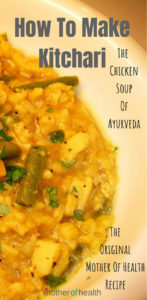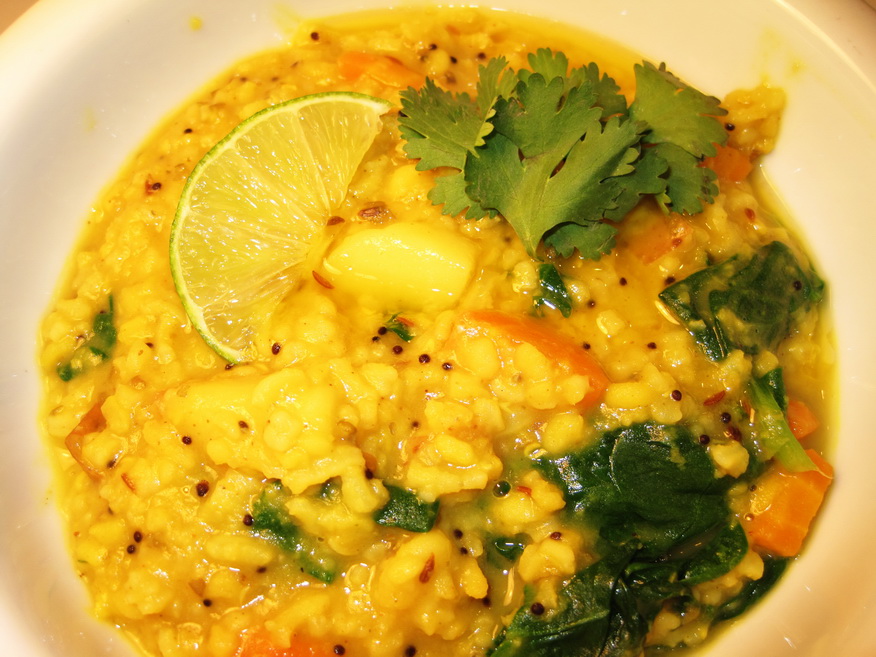Are you nervous about committing to an Ayurvedic cleanse because you're unsure about how to make Kitchari? (kit-cha-ree) Here we show you exactly how to make a delicious, healing pot of kitchari.
What is Kitchari?
Kitchari is a delicious classic Ayurvedic stew traditionally eaten during periods of fasting or cleansing. It's ideal because it's easy to digest and provides strength and good nourishment for the body so it can cleanse.
Split mung beans and basmati rice are a complete protein combination that nourishes and supports all the tissues and organs of the body.
Why Is It Good For You?
Kitchari is typically taken during times of cleansing or fasting to help improve digestion, and remove heaviness, congestion and accumulated toxins from the body and mind. It's ideal because it's easy to digest and provides strength and good nourishment.
Kitchari has a comforting creamy taste and it can have endless spice variations to fire up your digestion.
Typically made with basmati rice, mung beans, turmeric, coriander, cumin, cardamom, cinnamon, cloves, and ginger. You can also add vegetables like green beans, Brussel sprouts, cabbage, carrots, celery, fennel, kale, or any leafy green.
If you are eating Kitchari for a cleanse be sure to use organic ingredients.
When to Eat Kitchari?
Kitchari can be eaten by anyone at any time, so no need to wait for a cleanse to enjoy this meal. We tend to eat it a few times a month in our home just because we love it.
Can Kitchari Be Reheated?
Yes, you can reheat Kitchari on a low temperature on stove top or use a steamer. If you are eating Kitchari during a cleanse you make your Kitchari each morning and then reheat throughout the day.
Can Kitchari Be Frozen?
Yes, you can store Kitchari is a container that is freezer-safe for up to 8 weeks. To reheat, add a bit of water and warm on stovetop to get a porridge-like consistency.
(Printable version below)
How to Make Kitchari
1/2 C Organic split or sprouted mung beans
1/2 C Basmati rice
2 C Chopped vegetables
4-6 C Broth (bone or vegetable)
1 TBS Ghee
1 TBS Turmeric
1 TSP Ground cumin
1 TSP Ground coriander
1 TSP Fresh minced ginger
1/2 tsp Mustard seeds
Salt and pepper
Wash the split mung beans and basmati rice. If you have time, let it soak for a few hours before cooking. (It will make it easier to digest.)
- Heat ghee in a pot and add mustard seeds till they ‘pop', then add additional spices till they release aroma. (30 seconds or so)
- Add beans and rice and 2 cups of whatever vegetables you're using.
- Mix and blend with spices and ghee.
- Add enough water or vegetable stock and bring to a boil for 5 minutes.
- Cover and simmer 30-40 minutes. If you have a pressure cooker or an Instant Pot after you blend it all together, cover and bring to pressure (it will hiss) for 1 minute. Turn off heat and wait 1 hour and it will be done to perfection.
- Salt and pepper to taste. Garnish with a squeeze of lime and chopped cilantro.
Makes approximately 4 servings.
Where To Buy Kitchari
If you are looking for a delicious yet convenient option to making Kitchari from scratch, here are two I can feel good about recommending.
Banyan Botanicals makes a 7-Day nutritious, Kitchari Kit with everything you need including rice, dal, and spices.

How to Make Kitchari
Ingredients
- 1/2 C Organic split or sprouted mung beans
- 1/2 C Basmati rice
- 2 C Chopped vegetables
- 1 tbsp Ghee
- 1 tbsp Turmeric
- 1 tbsp Ground cumin
- 1 tsp Ground coriander
- 1 tsp Fresh minced ginger
- 1/2 tsp Mustard seeds
- salt and pepper
Instructions
- Wash the split mung beans and basmati rice. If you have time, let it soak for a few hours before cooking.
- Heat ghee in a pot and add mustard seeds till they "pop. Then add additional spices till they release their aroma. (30 seconds or so).
- Add beans and rice and 2 cups of whatever vegetables you're using.
- Mix and blend with spices and ghee
- Add enough water or vegetable stock and bring to a boil for 5 minutes.
- Cover and simmer 30-40 minutes. If you have a pressure cooker or an Instant Pot after you blend it all together, cover and bring to pressure for one minute. Turn off heat and wait 1 hour and it will be done to perfection.
- Salt and pepper to taste. Garnish with a squeeze of lime and chopped cilantro.
Ayurveda Lifestyle Products






In the ingredients it says 1 C veggies and in the instructions it says 2 cups. Which one do you prefer? Thanks
THANK YOU! Good Catch! It should read two cups. It can sometimes depend on what kind of veggies you’re using, so eye-ball it between 1-2 cups though. You want it to be a bit more on the stew side (unless you like more broth). Let me know how it turns out? Thanks again.
If you are using the pressure cooker, shouldn’t it take less time to cook? 1 hour seems like a long time.
Hey Jen,
Thanks for writing to get clarity.
Here’s what the recipe says: Cover and simmer 30-40 minutes. If you have a pressure cooker or an Instant Pot after you blend it all together, cover and bring to pressure (it will hiss) for 1 minute. Turn off heat and wait 1 hour and it will be done to perfection.
What I mean by this is if you let it pressure cook for 1 minute, but then turn off heat and wait an hour (while it continues to cook under pressure) it should be done to perfection. If it’s still not clear or you have a comment or question, please don’t hesitate to ask. I’ve been perfecting this recipe for over 20 years and have made it hundreds of times, so it should be perfect. 🙂
Hi Jackie, just to clarify. If i’m making this in a pot on the stove, after simmering for 30-40 minutes while covered, do I need to let it sit for an hour with the heat turned off as directed for the pressure cooker option? Thanks!
Hi Cherie,
If you are making your Kitchari in a pot on the stove (simmering for 30-40 minutes) there is no need to let it sit for an hour. Those instructions are only for the pressure cooker or InstaPot.